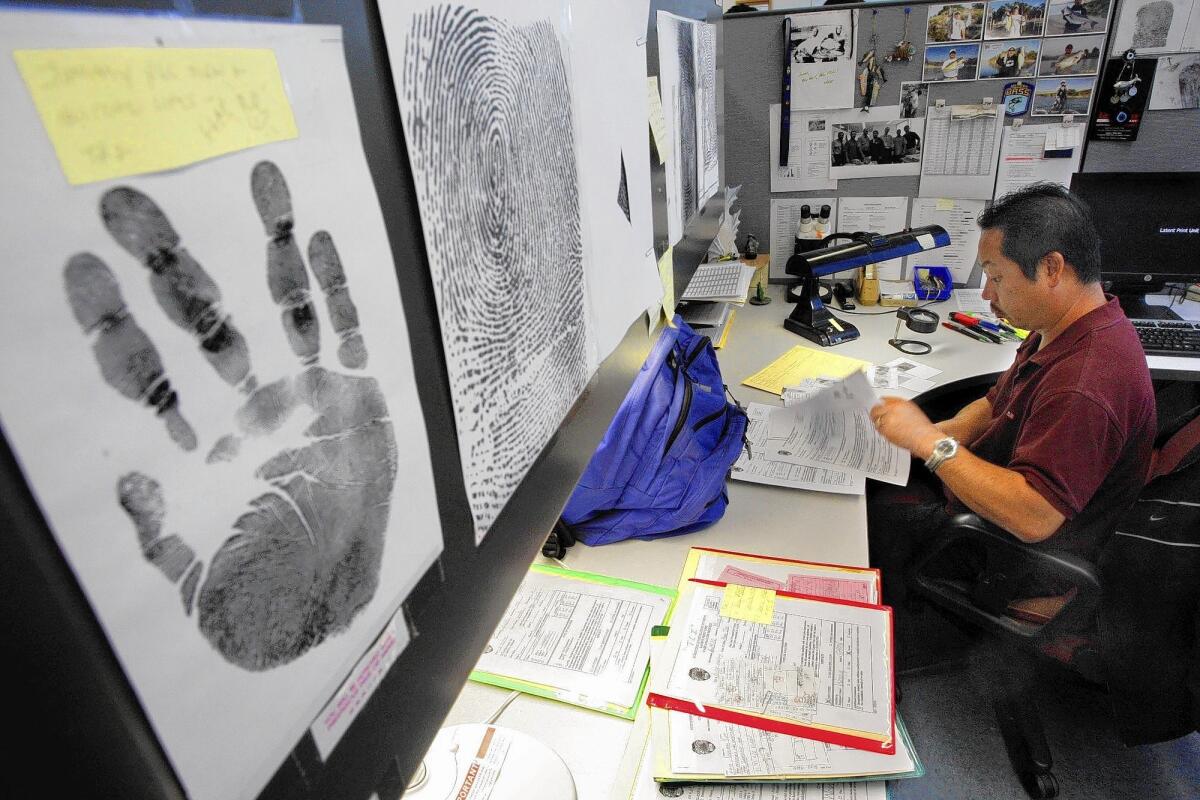LAPD fingerprint backlog more than doubled in the last two years

- Share via
Los Angeles police officials said Tuesday that the number of cases with unanalyzed fingerprint evidence has more than doubled in the last two years, hampering efforts to solve thousands of burglaries, thefts and other property crimes.
The backlog has worsened despite an LAPD campaign to process fingerprints more effectively, including having officers rather than analysts collect fingerprints at some crime scenes. In 2012, the backlog was about 2,200 cases. Today, there are 5,455.
LAPD Deputy Chief Kirk Albanese told the civilian-led Police Commission the delay was so severe that some fingerprints were now useless because the three-year deadline for prosecuting offenders had passed.
“There are cases that we don’t get to that would generate a suspect identification,” Albanese said. “For me to say otherwise would be disingenuous.”
Chief Charlie Beck described the backlog as “very problematic” and attributed the delays to a staffing shortage within the LAPD’s Latent Print Unit. He said city officials were “very aware” of the department’s request to hire more analysts: “We’re working toward that.”
The problem is likely to persist in the coming months because the current staffing level makes it nearly impossible to chip away at the backlog, Albanese said. The unit now has 60 employees, 36 fewer than full capacity. The last hire, Albanese said, was in January 2009.
Although the department has been authorized to hire eight analysts in March, Albanese said it would be next fall before they could work in the field alone.
“The reality is, at the current staffing, there are going to be cases … we are going to be unable to get to,” he said.
After the 2,200-case backlog was identified in 2012, the LAPD took steps to reduce the workload on the fingerprint unit. Officers were trained to collect prints at some crime scenes, allowing analysts more time in the lab to work other cases. When funding occasionally opened up, some was directed to the unit.
The department also prioritized which cases were sent to the unit. Fingerprints from all violent crimes are examined within an eight-week period. But testing fingerprint evidence in property crimes has been significantly restricted. Police stations and specialized divisions can request fast-tracked analysis in only 10 property crime cases during a four-week period.
“We can’t get to every property crime. We just can’t,” Albanese told The Times. “As much as that frustrates us, much like an emergency room, we have prioritized and we are taking what is the greatest risk to public safety first.”
Albanese said the backlog had increased because the unit remained short-staffed.
The Latent Print Unit can handle 285 cases every four weeks, Albanese said. But the demands on the unit are much higher: The unit typically receives about 600 cases every month.
In 2012, when 70 analysts worked for the department, Albanese said the unit could handle about 100 more cases every four weeks.
Albanese said that not all the backlogged fingerprint evidence would result in identification of a suspect. Many of the prints collected are not of sufficient quality to be successfully tested, he said.
The addition of eight analysts next year will help reduce the number of cases going on the waiting list, Albanese said, but the problem won’t be fully addressed until the city authorizes about 28 more hires.
“We’re going to have to do the very best we can with the resources we have until the city is able to allow us to hire to our authorized strength,” Albanese said.
More to Read
Sign up for Essential California
The most important California stories and recommendations in your inbox every morning.
You may occasionally receive promotional content from the Los Angeles Times.












